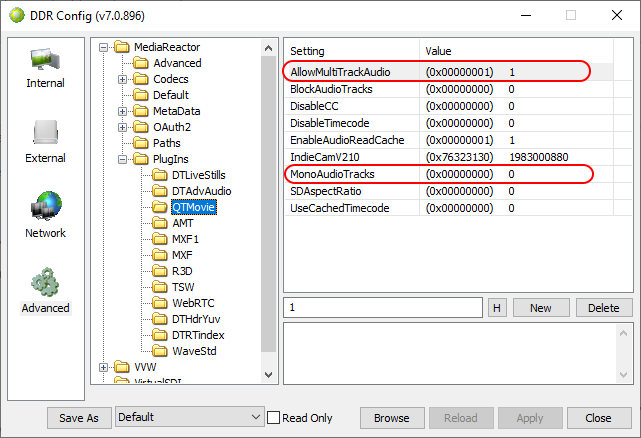 Drastic software can support up to 16 channels of audio. These can be 16 mono channels, 8 stereo pairs or all channels in one, depending on the setup and file type. This article covers the kinds of audio that the software can produce, and the audio setups it is able to read automatically to combine multiple channels of audio with video.
Drastic software can support up to 16 channels of audio. These can be 16 mono channels, 8 stereo pairs or all channels in one, depending on the setup and file type. This article covers the kinds of audio that the software can produce, and the audio setups it is able to read automatically to combine multiple channels of audio with video.
Creating Audio
For audio file creation, you can use MediaReactor or Net-X-Code Server. For playback and reading, this also applies to videoQC and the DTMediaRead SDK.
When writing video and audio, generally the first two audio channels will be embedded in the video file, and the rest will be written as stereo wave files in the same directory with the same base name and their channels added to the file name like this:
Testrecord.avi (one video track and 2 audio tracks)
Testrecord.A34.wav
Testrecord.A56.wav
Testrecord.A78.wav
Testrecord.A9A.wav
Testrecord.ABC.wav
Testrecord.ADE.wav
Testrecord.AFG.wav
This group contains 16 channels of audio, and when playing, all the channels would be picked up automatically by the reader. This is what as known in the software as 'Normal Wave'. There is also 'Normal Aiff' which is exactly the same, except the .wav files are .aiff. If the video file cannot contain audio (like TGA, TIFF, DPX, JS, YUV, etc), then the first audio pair would be written to a file called Testrecord.wav.
Aside from the 'Normal' record types, all the audio can also be forced into one or more wave or aiff files. In this case, no audio is stored in the video file. The alternate types include
- Wave Mono External - each audio channel is placed in its own mono wave file
- Wave Stereo External - each pair of audio channels are placed into their own stereo wave file
- Wave Multi-Channel - all audio channels are combined into one 'extensible' wave format file
- Aiff Stereo External - each pair of audio channels are placed into their own stereo AIFF file
With audio recording, there are also a number of exceptions, and special setups available:
- Sony XDCam MXF - requires 8 channels of 24 bit audio
- Sony HDCam MXF - requires 12 channels of 24 bit audio
- Avid Op-Atom MXF - all audio is saved as mono MXF files with links to the main video file
- Avid OP1a MXF - all audio is saved in the video MXF file
- Omneon OP1a MXF - all audio is saved in the video MXF file
- Panasonic P2 MXF - all audio is saved as mono MXF files in the AUDIO directory with links
- Series of TGA/TIFF/DPX/YUV - cannot contain audio, so all audio will go into WAVE or AIFF files
- MOV - supports normal audio, or can be set up to write multi-channel audio in the MOV. See the note on this below:
Setting up MOV Multi-channel Audio
To set up multi-channel recording into MOV files, you will need to use the DDRConfig advanced configuration tool. Run DDRConfig and select the Advanced tab. There are two settings that control how audio is written into MOV files.

Playing Audio
When reading audio, Drastic software will first check for external audio in WAVE or AIFF files. This allows you to override the internal audio in a file simply by placing a correctly named WAVE or AIFF file next to the video file. Once all the external wave files are found, any audio in the video file is used. For simple formats like AVI, this is usually the first pair of audio channels. For more complex formats like MXF, GXF and MOV, there can be anywhere from 1 to 16 channels of audio associated with the video file.
General Audio File Naming
Here are the primary types of external (audio only) uncompressed audio files:
- AIFF 16 Bit Big Endian Stereo
- AIFF 20 Bit Big Endian Stereo
- AIFF 24 Bit Big Endian Stereo
- AIFF 32 Bit Big Endian Stereo
- WAVE 16 Bit Stereo
- WAVE 16 Bit Extensible Multi Channel
- WAVE 16 Bit Mono (for WMV/Matrox compatibility)
- WAVE 20 Bit Stereo
- WAVE 24 Bit Stereo
- WAVE 24 Bit Extensible Multi Channel
- WAVE 32 Bit Stereo
Regardless of the file type, the audio files will always have the same naming conventions. For the examples below, the '.video' is the video source file. The '.wav' could equally be '.aiff' files.
BaseName.video (BaseName.avi, BaseName000001.dpx, etc)In
BaseName.wav (or BaseName.wav or BaseName.A12.wav)
BaseName.A34.wav
BaseName.A56.wav
BaseName.A78.wav
BaseName.A9A.wav (channels 9 and 10)
BaseName.ABC.wav (channels 11 and 12)
BaseName.ADE.wav (channels 13 and 14)
BaseName.AFG.wav (channels 15 and 16)
- If the video file is a series of stills, then the base name is everything before the numeric count. For example:
BaseName_000001.tga
BaseName_.wav
BaseName_.A34.wav
- The correct naming for a group of mono files is:
BaseName.video
BaseName.a1.wav
BaseName.a2.wav
BaseName.a3.wav
BaseName.a4.wav
BaseName.a5.wav
BaseName.a6.wav
BaseName.a7.wav
BaseName.a8.wav
BaseName.a9.wav
BaseName.aa.wav (channel 10)
BaseName.ab.wav (channel 11)
BaseName.ac.wav (channel 12)
BaseName.ad.wav (channel 13)
BaseName.ae.wav (channel 14)
BaseName.af.wav (channel 15)
BaseName.ag.wav (channel 16)
Stereo pairs may be missing, but mono files may not. Any missing stereo channels channels will be filled with silence
Alternate Audio File Naming
There are a couple of other supported naming conventions which are there purely to support third party software packages. These include:
BaseName.video
BaseName.aa.wav (one stereo pair only)
BaseName.video
BaseName_1.wav (dual mono files)
BaseName_2.wav (one stereo pair total)
BaseName.video
BaseName.1.wav (dual mono files)
BaseName.2.wav (one stereo pair total)
BaseName.video
BaseName_R.wav (dual mono files)
BaseName_L.wav (one stereo pair total)
BaseName.video
BaseName.r.wav (dual mono files)
BaseName.l.wav (one stereo pair total)
BaseName.video
BaseName.wav (these are all mono wave files)
BaseName_A2.wav
BaseName_A3.wav
BaseName_A4.wav
BaseName_A5.wav
BaseName_A6.wav
BaseName_A7.wav
BaseName_A8.wav
BaseName.video
audio.wav
audio12.wav
audio34.wav
audio56.wav
audio78.wav
BaseName.video
audio.wav
default.wav
audio.wav
default.aiff
default.aif
default.a1.wav/default.a2.wav
00000001_1.wav/00000001_2.wav
SSD1.WAV/SSD2.WAV
MOV Audio
MOV files can contain unlimited numbers of audio channels. For reading, we support the major/most common types. These include
- Multiple mono tracks
- Multiple stereo tracks
- Single stereo followed by mono tracks
- Single track with 5.1 audio
- Single track with multi-channel audio
MOV files can have 16, 20, 24 or 32 bit audio.
MXF Audio
MXF can handle a large number of audio tracks. For reading, we support most standard MXF types and layouts. With file formats like P2 and AS-02, the reader will automatically find and use external audio tracks pointed to by the main MXF video file.
Trademarks, Registered Trademarks, and CopyrightsTrademarks, Registered Trademarks, and Copyrights
Drastic Technologies, Ltd. – trademarks specified here.
Matrox Electronic Systems, Ltd - Matrox and Matrox product names are registered trademarks and/or trademarks of Matrox Electronic Systems, Ltd.
Omneon Video Networks, Inc - Omneon is a trademark of Omneon Video Networks, Inc
Panasonic Holdings Co., Ltd - Panasonic, and Varicam are trademarks of Panasonic Holdings Co., Ltd
Sony Corporation – Sony, Sony DVD Architect, DVD, Catalyst, and Vegas are trademarks of Sony Corporation and/or its affiliates.
All other trademarks are the property of their respective owners.

